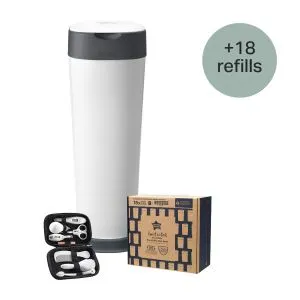
Ultimate XL Nappy Disposal Bundle with 18 Refills
Bundle & Save 40%
Subscription orders can be cancelled at anytime. Free delivery on all subsequent subscription orders. Find out more about subscriptions.
They’re easy and fuss free
Your products are automatically sent to you
You save up to 10% when you sign up for a subscription
You can cancel at any time

Babies are born with a natural reflex to seek out their parents breast for feeding - but getting into the right breastfeeding position can take some getting used to.
The truth is, finding the best breastfeeding positions for you and your baby takes time, practice, and lots of patience. To help you figure out which breastfeeding position is best for you and your little one, let's run through some of the most popular feeding positions. We'll also cover some top breastfeeding do's and don'ts.
Getting a baby to latch on properly is easier if they're calm and displaying early feeding cues. These includesucking their fingers or fist, turning their head and opening their mouth, or making murmuring noises. If they're restless, it can help to hold them, talk to them, walk around with them, or rock them gently before you start a feed.
There are lots of different breastfeeding positions, and the one that works best for you and your baby will depend on what makes you both feel comfortable and relaxed. Usually, parents find they need to try a few different positions to discover which one works best for them. They may sometimes find that they need to adapt to laid-back positions as their baby gets older, grows bigger, and is heavier to hold.
Before you get started, try to relax, and keep everything you'll need during the feed close by, including a big drink of water to keep you hydrated.
Breastfeeding while lying down might be a good option for you if you've had a caesarean section, as it won't put pressure on your stomach. Certain laid-back positions can also be suitable for breastfeeding during the night.
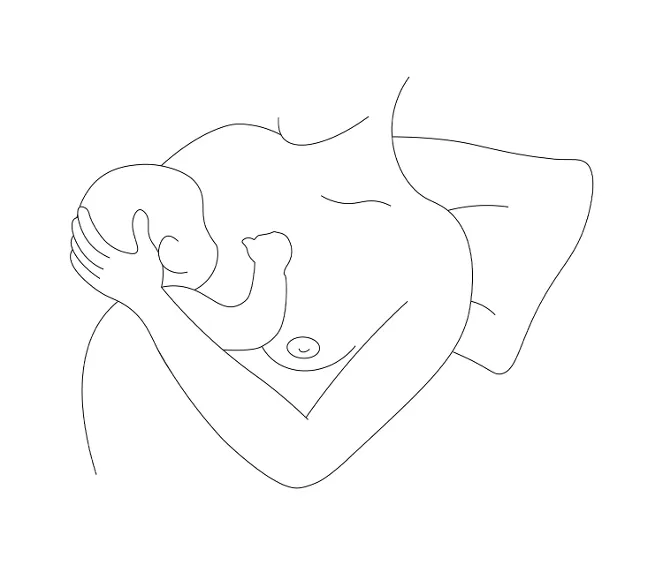
Also known as "biological nursing", the laid-back breastfeeding position gives you and your baby snug comfort and support.
This position encourages your baby's feeding instincts and can encourage a deeper latch. This can help avoid certain breastfeeding issues, like sore nipples.
Simply lean back on your bed or in a chair and support yourself with pillows in a semi-reclined position. This position encourages your baby to latch on naturally, and all you need to do is lie back and relax.
Your baby should be positioned with their tummy on your tummy (or to one side if that's more comfortable), and you should be positioned upright enough to look into their eyes.
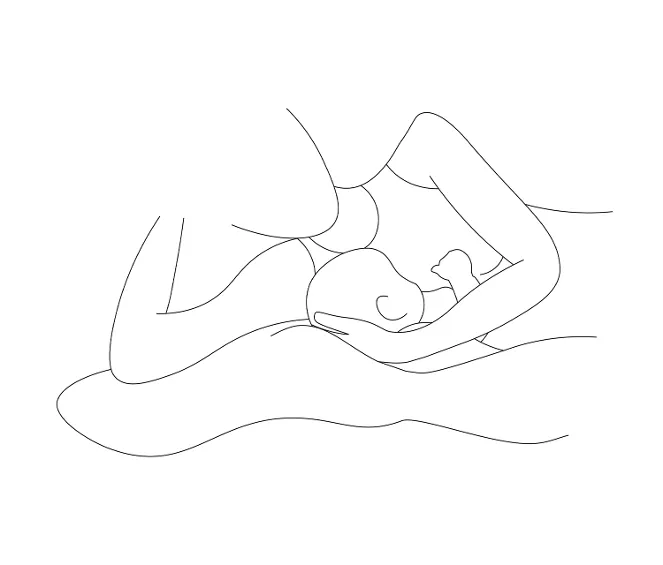
Breastfeeding lying down on your side is another popular position, particularly at nighttime.
You and your baby lie side by side facing each other. Rolling up a blanket and putting it behind your baby's back will keep them from rolling away from you. Similarly, you can try using a pillow behind your back or between your knees for extra support. You can also cradle your baby with your forearm along their back to help them feed.
Baby should be lying tummy to tummy - and you should check to ensure their ear, shoulder and hip are positioned in a straight line. Additionally, if you're putting a pillow under your head, make sure that it's not too close to your baby's head and that they're a safe distance away from any duvets or extra pillows on the bed.
Placing a folded towel or a thin pillow under your ribs can help lift and support your body, and can be especially useful if you've got bigger breasts.
Upright breastfeeding positions can be a good option for when you're out and about. They also offer more versatility as your baby gets bigger.
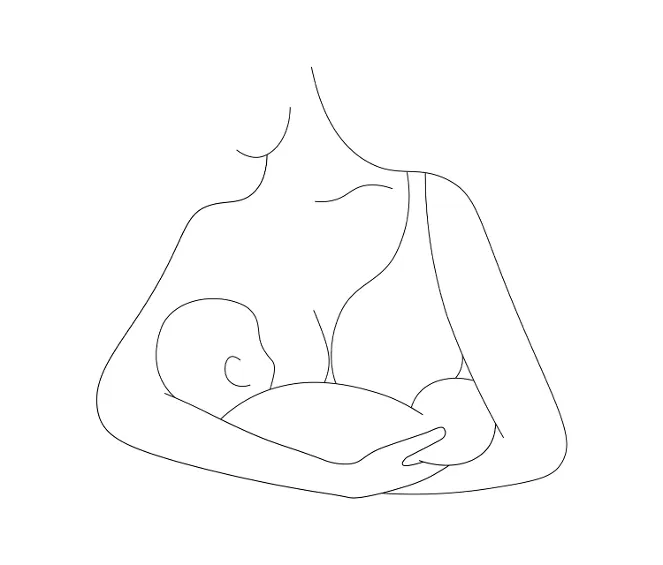
The cradle-hold breastfeeding position is the classic position that probably springs to mind when you think about breastfeeding.
Sit upright and position your baby on their side, with their neck resting on your forearm and their body positioned against your stomach. Having a cushion behind you is recommended to avoid back strain.
If you decide to use a breastfeeding pillow on your lap, be sure it doesn't position your baby higher than necessary to avoid them straining to latch. This position can often lead to baby's head being forced into an angle while feeding. So, you should check that they're in a straight line and not off to one side.
Sitting with your feet resting on a stool while breastfeeding in a cradle hold can help support your back. Putting your hand across baby's shoulders rather than their head can also help to achieve a deeper latch.
It's worth noting that this position may be uncomfortable if you've had a caesarean section.
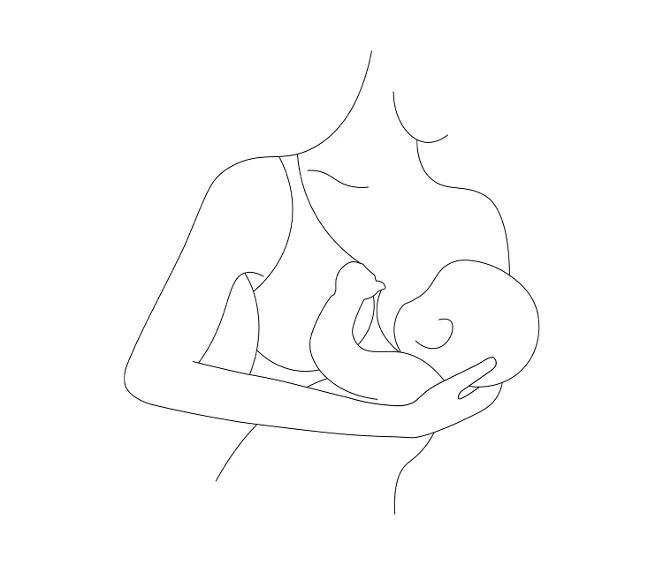
The cross-cradle hold is like the cradle hold, except your arms switch roles so that your opposite forearm is supporting your baby's body. This breastfeeding position is good for newborns, small babies, or babies with difficulties latching on to the nipple.
The aim is to support baby around their neck. But it's best to avoid holding their head as this can push their chin into their chest.
Simply hold your baby using the arm that's opposite to the breast you're feeding from (making sure to support their neck and head). With your other hand, support your breast and cradle your baby close to it.
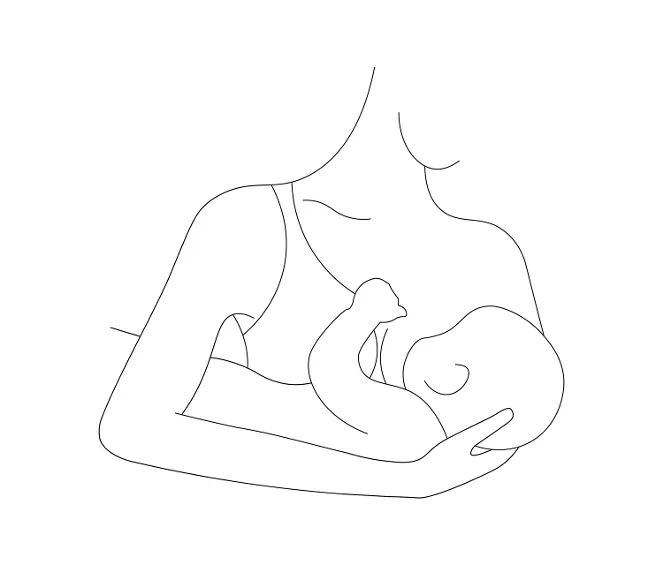
The rugby breastfeeding hold (sometimes called the 'clutch position') can be achieved by cradling your baby in one arm - using your palm to support their neck - and nestling them closely against your side with their legs tucked underneath your arm.
This position is particularly comfortable for newborn babies. It helps them to handle your milk flow easier if you have a forceful letdown.
This breastfeeding position is also a good option for:
Because it's guided and doesn't allow the baby to use their feeding reflexes, parents often find that their little one quickly outgrows this position. It can also be difficult for parents to maintain as their baby gets bigger and heavier.
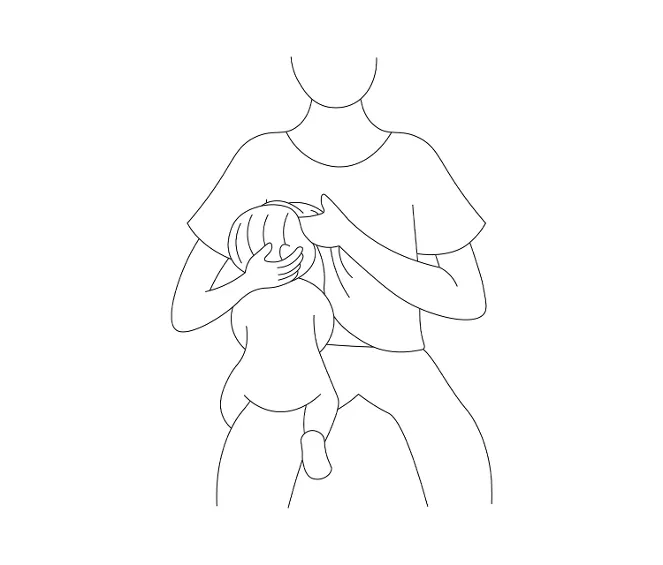
The straddle hold - also known as upright breastfeeding or the koala hold - requires a baby to sit straddled on their parents thigh or hip, with their head upright as they breastfeed.
This position is suitable for babies of various ages (although younger babies will need plenty of head support). It's also a comfortable choice for little ones who have an ear infection, reflux, or a tongue tie.
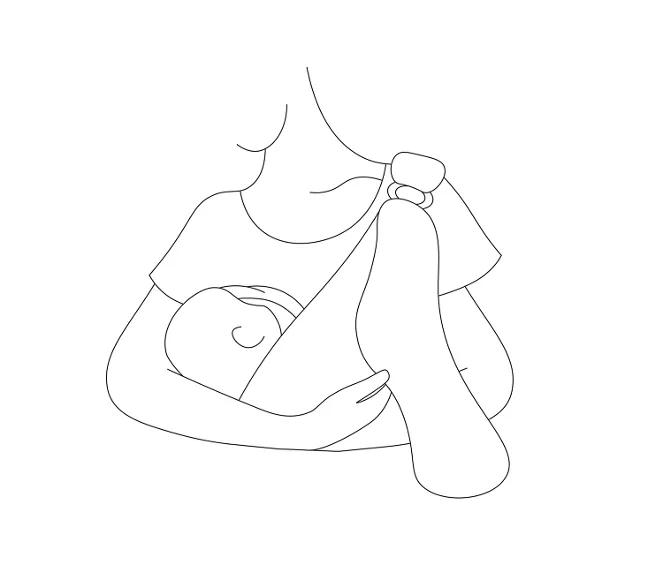
Parents who're out and about may find that breastfeeding while their baby is in a sling is very convenient and keeps their hands free.
Feeding while wearing a sling is best suited to older babies who can hold their head up independently. It can also be suitable for babies who want the comfort of being close to their parents body while feeding.
When feeding while wearing a sling, it’s important to make sure you can always see your baby’s face and that their chin isn't pressed in against their chest.
Certain breastfeeding positions can be bad for your baby and should be avoided, including:
If your baby isn't positioned properly when they're breastfeeding, your breast milk supply may not be stimulated properly, and your baby won't get enough milk during the feed.
Incorrect positioning while breastfeeding can also lead to a poor latch, which can make your nipples painful.
Sometimes babies will unlatch mid-feed. So, if your baby unlatches from your breast while feeding, give them a minute before reattaching, as they may just want a rest from feeding.
Now that we’ve covered the different position that you and your baby can sit in while breastfeeding, let’s look at the different ways you can hold your breasts while they feed to encourage a good latch that’ll keep you both comfortable.
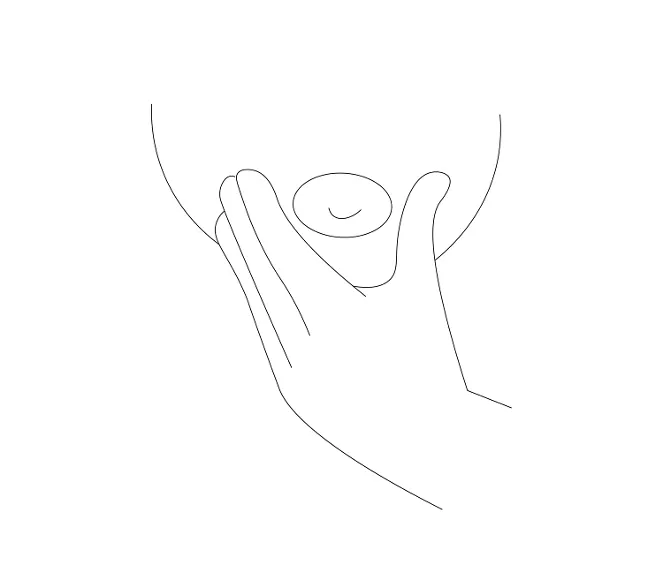
Just like the name suggests, hold your breast with your free hand in a U-shape.
This hold supports your breast and lets baby latch correctly. It’s commonly used with side-lying and laid back breastfeeding positions.
Your breast should sit in the palm of your hand. With your thumb on one side of your nipple and your forefinger on the other.
Make sure that your fingers don’t get in the way when your baby is feeding.
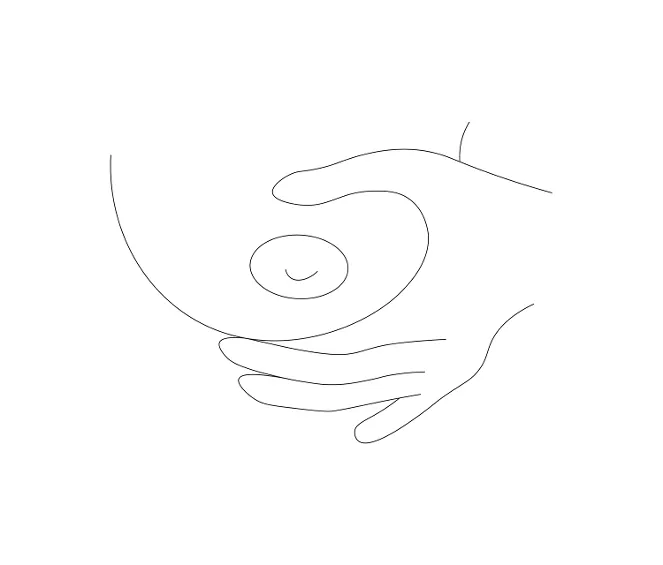
Similar to the U-hold but turned to the side, this hold requires you to position your hand in the shape of the letter C.
To get into the C-hold, place your breast in the palm of your hand with your fingers on the bottom and your thumb on top.
This hold may make it easier to comfortable manoeuvre baby to your breast if you have larger breasts.
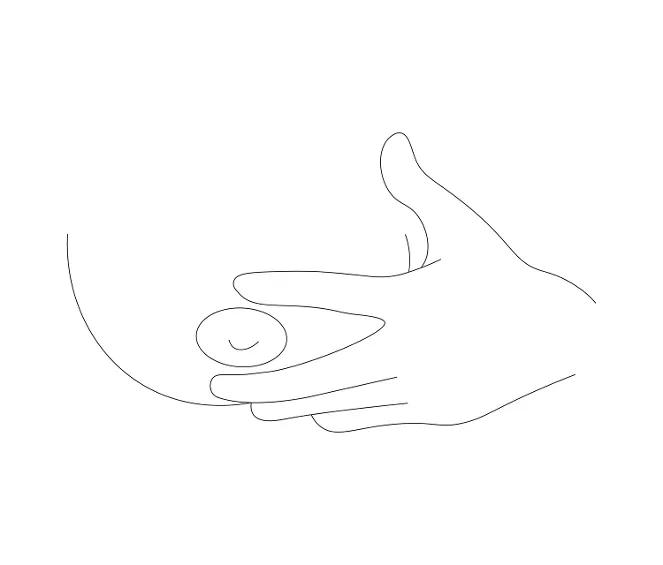
Also known as the scissor grasp, the V-hold is perfect for breastfeeding parents with smaller breasts or slightly inverted nipples. This hold means that baby can put more of the breast in their mouth to achieve a better latch.
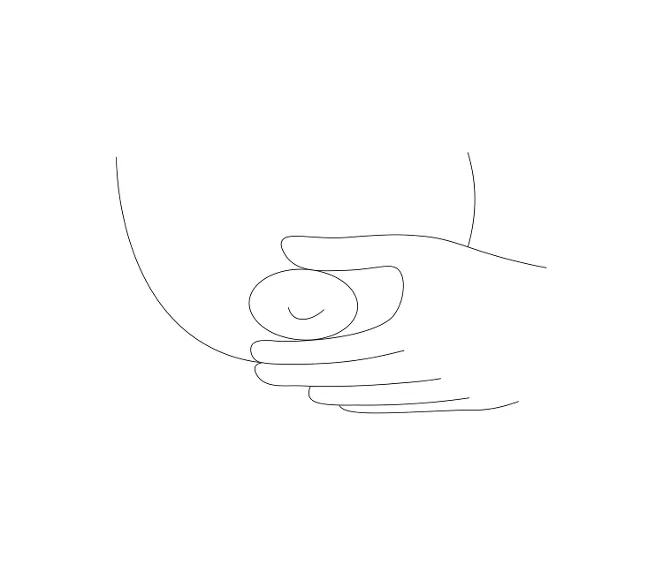
This hold is like the C and V-hold combined with a slight squeeze.
Place your breast in the palm of your hand with your index finger on the bottom and your thumb on top of your nipple. Then gently squeeze your nipple out to avoid your fingers being in the way of baby latching.
Explore the Range
If you're concerned about your baby's breastfeeding habits, don't hesitate to get their feeding position and latch checked by your health visitor, midwife or a lactation consultant.
The time it takes to breastfeed your baby depends on several factors, such as your milk flow, your baby's age, and their alertness at the time of the feed. For example, a sleepy baby will likely take longer to feed than a fully rested baby.
A breastfeeding session with your baby might take anywhere between five and 45 minutes, and the average feed often lasts somewhere between 10 and 20 minutes.
If you find that your baby is only feeding for five minutes at a time, you may want to encourage them to feed for longer and keep an eye on their weight gain and growth.
Breaking the suction before pulling your baby away from your breast is key to avoiding sore nipples.
To help your baby unlatch, try gently inserting your little finger into the corner of their mouth to break the suction. Then quickly remove the nipple from their reach so they can't latch on again.
You can also try very gently pulling down on your baby's chin until their mouth opens wider, then unlatching your nipple.
The rugby hold can be more comfortable for parents who've had a C-section, as it keeps your baby away from the abdominal incision.
The laid-back or side-lying positions may also be a more comfortable option than sitting, as they both let you avoid having any weight or pressure on your stomach or wound.
Either the laid-back or cross-cradle breastfeeding hold are good options for breastfeeding a newborn. The cradle hold doesn't give as much support to the baby, so may not be best suited to newborns.